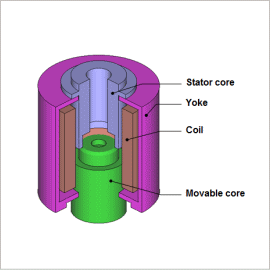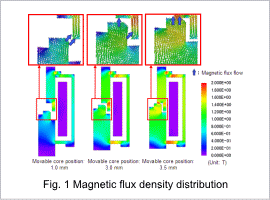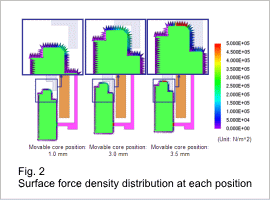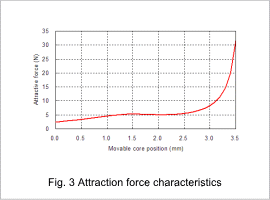*Please prepare a license ID and password for the license administrator.
*It is different from the service for JMAG WEB MEMBER (free membership). Please be careful.
Overview

Solenoid valves move their iron cores in a translational direction, and are used to adjust the inflow and outflow amounts of liquids and gasses. Running current through the coil forms an electromagnet, which generates an electromagnetic attraction force between the mover and stator. A high level of responsiveness is required to open and close the valve, so the power supply and valve used in the drive need to be evaluated to determine whether they fulfill the required responsiveness and attraction force.
The attraction force is determined from the size of the current, the arrangement of the iron core, and the material properties. However, the actual flow of magnetic flux is complex, and even if the current is increased, phenomena may occur such as the attractive force not being proportional to the current due to the effects of magnetic saturation in the core. A magnetic field analysis simulation using the finite element method (FEM) is useful in studying these kinds of behaviors.
This Application Note obtains the attraction force at each position of the movable core.
The attraction force is determined from the size of the current, the arrangement of the iron core, and the material properties. However, the actual flow of magnetic flux is complex, and even if the current is increased, phenomena may occur such as the attractive force not being proportional to the current due to the effects of magnetic saturation in the core. A magnetic field analysis simulation using the finite element method (FEM) is useful in studying these kinds of behaviors.
This Application Note obtains the attraction force at each position of the movable core.
Magnetic Flux Density Distribution

The magnetic flux density distribution for each position of the movable core is shown in fig. 1. As the movable core gets closer to the stator core, the space between them shrinks, so the magnetic flux flowing in the direction of movement increases and the magnetic circuit changes. The magnetic circuit between the movable core and stator core affects the attraction force characteristics.
Attraction Force Characteristics
Fig. 2 shows a vector plot of the surface force density produced in the movable core at each position, and fig. 3 shows the attraction force characteristics of the solenoid valve.
When the movable core is in a position of 1.0 mm to 2.5 mm, a basically constant attraction force is obtained. As the movable core gets closer to the stator core the space between them shrinks, causing the magnetic resistance to change rapidly. This is why the attraction force generated in the direction of movement changes depending on the movable core’s position when there is direct current excitation.




